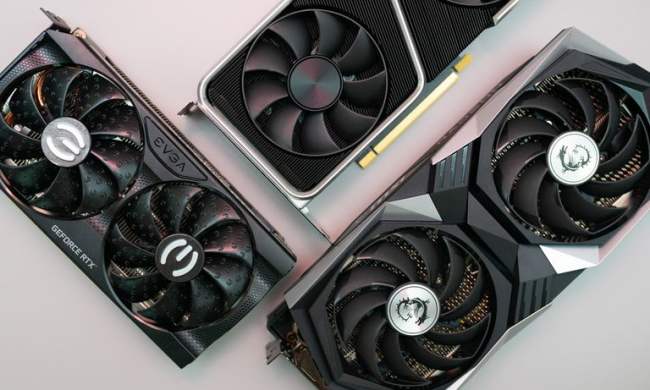 Jacob Roach / Digital Trends
Jacob Roach / Digital Trends
Nvidia overwhelmingly dominates the list of the best graphics cards, and that largely comes down to its feature set that’s been enabled through DLSS. AMD isn’t sitting idly by, however. The company is researching new ways to leverage neural networks to enable real-time path tracing on AMD graphics cards — something that, up to this point, has only really been possible on Nvidia GPUs.
AMD addressed the research in a blog post on GPUOpen, saying that the goal is “moving towards real-time path tracing on RDNA GPUs.” Nvidia already uses AI accelerators on RTX graphics cards to upscale an image via DLSS, but AMD is focused on a slightly different angle of performance gains — denoising.
 AMD
AMDWhen enabling path tracing in a game like Alan Wake 2 or Cyberpunk 2077, you’re only getting a small fraction of the rays cast into the scene. In a real-time context, only a handful of samples per pixel are cast into the scene, and they bounce around, but rarely go back to a light source within the scene. That leads to a noisy image — see the top left of the image above — that needs to be cleaned up with denoising. AMD is applying a neural network to the denoising process.
Nvidia has this technique covered already with Ray Reconstruction, which is a DLSS feature that’s sorely underrated. It makes a massive difference in image quality, preserving details in path tracing that would normally take minutes or hours to render for a single frame offline. AMD is looking at something similar: taking a small number of samples per pixel and reconstructing the fine details of path tracing using a neural network.
Get your weekly teardown of the tech behind PC gaming
The technique AMD is researching, however, combines upscaling and denoising into a single neural network. “We research a Neural Supersampling and Denoising technique which generates high-quality denoised and supersampled images at higher display resolution than render resolution for real-time path tracing with a single neural network,” the blog post reads. “Our technique can replace multiple denoisers used for different lighting effects in rendering engine by denoising all noise in a single pass, as well as at low resolution.”
This looks like some foundational research for the next version of AMD’s FSR, which could finally match Nvidia on performance and image quality. The lingering question is if these techniques require any bespoke hardware. Nvidia claims that dedicated accelerators on its RTX graphics cards are necessary for AI-assisted upscaling and denoising with DLSS, so AMD may need dedicated hardware on its GPUs, too.
However, there is a world where AMD could open up FSR 4 — or whatever the next version is called — to all graphics cards while still leveraging a neural network. RTX GPUs already have the hardware, and we’ve seen with features like Intel’s XeSS that it’s possible to run AI models on GPUs through separate instructions, though usually with a hit to image quality and performance.

Jacob Roach is the lead reporter for PC hardware at Digital Trends. In addition to covering the latest PC components, from…
I’ve reviewed every AMD and Nvidia GPU this generation — here’s how the two companies stack up

Nvidia and AMD make the best graphics cards you can buy, but choosing between them isn't easy. Unlike previous generations, AMD and Nvidia trade blows point-for-point in 2024, and picking a brand to go with isn't as easy as counting the dollars in your wallet.
I've reviewed every graphics card AMD and Nvidia have released this generation, comparing not only raw performance, but also features like DLSS and FSR, ray tracing performance, and how VRAM works in modern games. After dozens of graphics card reviews, here's how AMD and Nvidia stack up against each other in 2024.
Nvidia vs. AMD in 2024
Read more
Nvidia just dropped a big hint about the RTX 50-series release date

Speculation has been running rampant about Nvidia's launch of next-gen RTX 50-series GPUs, but the company itself just dropped a big hint about when they may show up. Nvidia CEO Jensen Huang is set to take the stage as the keynote speaker of CES 2025 on January 6, where there's a good chance we'll hear about Nvidia's next generation of graphics cards.
Although Nvidia is at the annual tech show each year, Huang -- who recently surpassed the worth of all of Intel -- hasn't made an appearance in five years. The executive will likely focus heavily on AI, as it has catapulted Nvidia to become one of the world's wealthiest companies. But RTX 50-series GPUs should make an appearance, too. Nvidia usually takes advantage of CES to launch new graphics cards.
Read more
Prime Day is the perfect time to ditch Nvidia for AMD

There's no doubt that Nvidia makes some of the best graphics cards you can buy, but if you're shopping Prime Day deals, you'll want to take a careful look at Team Red. There's barely an Nvidia GPU in sight that's on sale, and even among those that are discounted, the prices aren't very good. On the other hand, AMD has cards marked down from already reduced prices, making Prime Day the perfect time to score a deal on a GPU.
By far, the best deal I've found is the XFX Speedster QICK319 RX 7800 XT. You can read more about the card in my RX 7800 XT review, but in short, it trades blows and sometimes even beats Nvidia's $600 RTX 4070 Super. The price right now is insane, too. This model normally sells for $520, but it's 18% off for Prime Day, bringing the price down to $427.
Read more





















 English (US) ·
English (US) ·